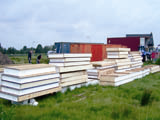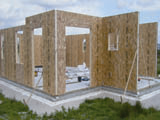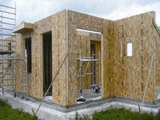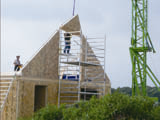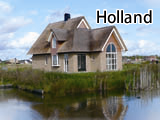
Quacent Project photos
PRODUCTS:Prefabricated House
Prefabricated House
A. Definition:
The word Prefab is used to describe any type of home that is made from easy-to-assemble building sections that were manufactured off-site, climate-controlled factory. The sections are then transported to the building site. Full sections of the prefabricated home are then assembled on the ready-made basement or foundation to manage lower labor cost and site time.
B. Advantages of prefab house:
.jpg)
1.Construction time is reduced and buildings are completed sooner, labor cost can be greatly reduced and allowing an earlier return of the capital invested
2.On-site construction and congestion is minimized, Quality control can be easier in a factory assembly line setting than a construction site setting.
3.Prefabrication can be located where skilled labor is more readily available and costs of labor, power, materials, space and overheads are lower
4.Time spent in bad weather or hazardous environments at the construction site is minimized.
5.Less waste may be generated and in a factory setting it may be easier to recycle it back into the manufacturing process
C. Types of prefab house we can fabricate:
Villas/cottage/cabin:

Garden office/shed:
1.a small stand alone building with insulation and electrical connections used as a dedicated office space - similar to studios, summer houses and garden rooms
2.Mobile house:
They are usually transported by tractor-trailers over public roads to sites which are often in rural areas or high-density developments. Often used for temporary accommodation on campsites. While these homes are usually placed in one location and left there permanently, they do retain the ability to be moved as this is a requirement in many areas.
3.Commercial building:
other than a residential building, including any building constructed for industrial or commercial use. Types can include office buildings, warehouses, or retail.

Panels are shipped to the jobsite for assembly when the foundation and deck are in place. After the bottom plate is attached to the perimeter, placement of the wall panels begins. Panels weigh approximately three pounds per square foot, so 4' panels are light enough to be carried and set by hand. Exterior walls for most houses can be erected in less than a day. Nails and adhesive foam are used to fasten the panels to top and bottom plates, and to make vertical connections. Gutter spikes or long screws are often used for SIP corner connections. Walls must be properly braced and plumbed, and interior walls are typically constructed with conventional framing. Beams that carry roof loads may require stud supports incorporated into wall panels, to carry point loads downward. Heavier roof panels are usually set in place with a crane.
To take full advantage of SIPs insulating capacity, care must be taken to seal all joints properly, but the relatively small number of connections makes this easier to accomplish. Spray polyurethane foam is often used to fill any voids or gaps, joints and details.



